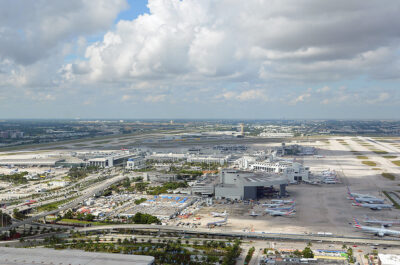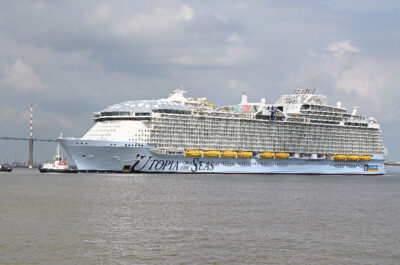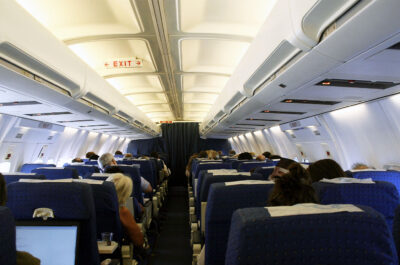U.S. scheduled passenger airlines employed 436,350 workers in September 2005, 5.5 percent fewer than in September 2004…
U.S. scheduled passenger airlines employed 436,350 workers in September 2005, 5.5 percent fewer than in September 2004, the U.S. Department of Transportation’s Bureau of Transportation Statistics (BTS) reported (Table 1).
BTS, a part of the Research and Innovative Technology Administration (RITA), reported that the seven network carriers employed 293,767 total full-time and part-time workers – 8.6 percent fewer workers in September 2005 than a year earlier (Table 2). The low-cost carriers reported 74,425 total employees, 0.5 percent fewer than September 2004 (Table 3); and the regional carriers reported 54,608 total employees, 3.3 percent more than the previous year (Table 4).
September was the ninth consecutive month of year-over-year declines in airline employment levels for the scheduled passenger carriers since BTS began tracking the numbers. For the first time in 2005, part-time employee numbers declined with a 0.5 percent decrease in September 2005 from September 2004 (Table 1).
Many regional carriers were not required to report employment numbers before 2003, so year-to-year comparisons involving regional carriers, or the total industry, are not available for the years before 2003. BTS is providing pre-2003 comparisons for network and low-cost carriers, as well as pre-2003 numbers for individual regional carriers that were required to report in earlier years.
Airlines that operate at least one aircraft with the capacity to carry combined passengers, cargo and fuel of 18,000 pounds – the payload factor – must report monthly employment statistics.
Employment data for Independence Air, which changed its business model from a regional to low-cost carrier in mid-2004, have been included with low-cost carriers for 2003, 2004 and 2005. This change reflects that carrier’s current business model as a low-cost operator.
Due to its recent purchase by Sky West Airlines, Atlantic Southeast Airlines was granted an extension for the filing of September employment numbers. As a result, its employment numbers are not included in any of the year-to-year totals for regional airlines in Tables 1, 4, 7 and 8.
Using Full-Time Equivalent Employee (FTE) calculations, employment at network carriers in September dropped 34.4 percent from 2001 to 2005. The biggest declines were at US Airways, down 51.8 percent; and United Airlines, down 43.7 percent (Table 5). In FTE calculations, two part-time employees are counted as one full-time employee.
The seven low-cost carriers, excluding Independence, that were required to report employment data in 2001 and 2005 employed 12.8 percent more FTEs in September 2005 than in September 2001 (Table 6).
The seven regional carriers that were required to report employment data in 2001 and 2005 employed 2.9 percent more FTEs in September 2005 than in September 2001. Of that group, Horizon Air and Air Wisconsin reported fewer FTE employees in September 2005 than September 2001 (Table 7).
Tables 1, 2, 3 and 4 use totals for full-time and part-time employees, while employee numbers in Tables 5, 6, 7 and 8 show FTEs.
The 5.8 percent drop in FTEs from September 2004 to September 2005 was the ninth consecutive month of year-over-year declines in airline employment levels for the scheduled passenger carriers. It was the largest decrease for that period. It was also the second consecutive month with a decline of more than 5 percent from the same month of the previous year (Table 8).
Network carriers operate a significant portion of their flights using at least one hub where connections are made for flights to down-line destinations or spoke cities. Low-cost carriers are those that the industry generally recognizes as operating under a low-cost business model with fewer infrastructure costs.
Regional carriers provide service from small cities, using primarily regional jets to support the network carriers’ hub and spoke systems.
The Other Carrier category generally reflects those airlines that operate within specific niche markets such as Aloha and Hawaiian Airlines in serving the Hawaiian Islands.
Table 1: Passenger Airline Employment, September 2004-2005
|
|
September 2004 |
September 2005 |
Pct. Change 2004-2005 |
|
Total (39) |
|||
|
Total |
461,628 |
436,350 |
-5.5% |
|
Full-time |
406,304 |
381,306 |
-6.2% |
|
Part-time |
55,324 |
55,044 |
-0.5% |
|
Network Carriers (7) |
|||
|
Total |
321,449 |
293,767 |
-8.6% |
|
Full-time |
283,301 |
257,009 |
-9.3% |
|
Part-time |
38,148 |
36,758 |
-3.6% |
|
Low Cost Carriers (8)* |
|||
|
Total |
74,778 |
74,425 |
-0.5% |
|
Full-time |
67,737 |
66,722 |
-1.5% |
|
Part-time |
7,041 |
7,703 |
9.4% |
|
Regional Carriers (13)*2 |
|||
|
Total |
52,848 |
54,608 |
3.3% |
|
Full-time |
46,084 |
47,639 |
3.4% |
|
Part-time |
6,764 |
6,969 |
3.0% |
|
Other Carriers (11)*3 |
|||
|
Total |
12,553 |
13,550 |
7.9% |
|
Full-time |
9,182 |
9,936 |
8.2% |
|
Part-time |
3,371 |
3,614 |
7.2% |
Source: Bureau of Transportation Statistics
* Independence Air (formerly known as Atlantic Coast Airlines) data have been included in 2004 and 2005 totals for low-cost carriers, reflecting the current change in its business model from its prior designation of regional carrier.
*2 Atlantic Southeast Airlines was granted an extension for the filing of September 2005 employment numbers. For year-to-year comparison purposes, its employment data were not included in this table.
*3 Other Carriers generally operate within specific niche markets. They are: Allegiant Air, Aloha Airlines, Casino Express Airlines, Continental Micronesia, Hawaiian Airlines, Midwest Airlines, Shuttle America, Sun Country Airlines, TransMeridian Airlines, USA3000 Airlines.
Table 2: Total Number of Employees: Network Carriers,
September 2001-2005
(number of current carriers in parentheses)
|
Total |
Pct. Chge from previous year |
Full-time |
Pct. Chge from previous year |
Part-time |
Pct. Chge from previous year |
|
|
2001 (8) |
446,950 |
N/A |
392,836 |
N/A |
54,114 |
N/A |
|
2002 (7) |
392,147 |
-12.3 |
346,047 |
-11.9 |
46,100 |
-14.8 |
|
2003 (7) |
327,209 |
-16.6 |
288,174 |
-16.7 |
39,035 |
-15.3 |
|
2004 (7) |
321,449 |
-1.8 |
283,301 |
-1.7 |
38,148 |
-2.3 |
|
2005 (7) |
293,767 |
-8.6 |
257,009 |
-9.3 |
36,758 |
-3.6 |
Source: Bureau of Transportation Statistics
Table 3: Total Number of Employees: Low-cost Carriers,
September 2001-2005
(number of current carriers in parentheses)
|
Total |
Pct. Chge from previous year |
Full-time |
Pct. Chge from previous year |
Part-time |
Pct. Chge from previous year |
|
|
2001 (11) |
65,725 |
N/A |
59,397 |
N/A |
6,328 |
N/A |
|
2002 (11) |
69,530 |
5.8 |
63,152 |
6.3 |
6,378 |
0.8 |
|
2003 (8) |
74,100 |
6.6 |
67,379 |
6.7 |
6,721 |
5.4 |
|
2004 (8) |
74,778 |
0.9 |
67,737 |
0.5 |
7,041 |
4.8 |
|
2005 (8) |
74,425 |
-0.5 |
66,722 |
-1.5 |
7,703 |
9.4 |
Source: Bureau of Transportation Statistics
Table 4: Total Number of Employees: Regional Carriers,
September 2003-2005*
(number of current carriers in parentheses)
|
Total |
Pct. Chge from previous year |
Full-time |
Pct. Chge from previous year |
Part-time |
Pct. Chge from previous year |
|
|
2003 (11) |
38,778 |
N/A |
33,962 |
N/A |
4,816 |
N/A |
|
2004 (13) |
52,848 |
36.3 |
46,084 |
35.7 |
6,764 |
40.4 |
|
2005 (13) |
54,608 |
3.3 |
47,639 |
3.4 |
6,969 |
3.0 |
Source: Bureau of Transportation Statistics
* Atlantic Southeast Airlines was granted an extension for the filing of September 2005 employment numbers. For year-to-year comparison purposes, its employment numbers were not included in this table.
Note: Regional group numbers for years before 2003 are not included because of the limited number of regional carriers that met the requirement for filing reports.
Table 5: Network Carrier FTE Employees, September 2001-2005*
(Ranked by September 2005 FTE Employees)
|
Rank |
2001 |
2002 |
2003 |
2004 |
2005 |
|
|
1 |
American*2 |
91,300 |
99,422 |
80,665 |
79,166 |
75,460 |
|
2 |
United |
95,836 |
79,121 |
59,609 |
58,447 |
53,916 |
|
3 |
Delta |
75,229 |
65,611 |
58,466 |
57,243 |
50,745 |
|
4 |
Northwest |
47,132 |
44,542 |
38,075 |
37,528 |
32,999 |
|
5 |
Continental |
39,662 |
36,818 |
34,580 |
34,512 |
32,587 |
|
6 |
US Airways |
42,909 |
33,302 |
26,270 |
25,672 |
20,663 |
|
7 |
Alaska |
10,157 |
10,283 |
10,028 |
9,809 |
9,018 |
|
8 |
TWA |
17,670 |
N/A |
N/A |
N/A |
N/A |
|
Total |
419,895 |
369,099 |
307,693 |
302,377 |
275,388 |
|
Rank |
Percentage
Full-time Employees |
||
|
2001
|
2005
|
||
|
1 |
American*2 |
86.4
|
86.2 |
|
2 |
United |
90.4
|
88.8 |
|
3 |
Delta |
83.0
|
88.9 |
|
4 |
Northwest |
96.3
|
94.1 |
|
5 |
Continental |
80.0
|
80.4 |
|
6 |
US Airways |
90.4
|
86.0 |
|
7 |
Alaska |
87.6
|
89.4 |
|
8 |
TWA |
94.3
|
N/A |
|
|
Total |
87.9
|
87.5 |
Source: Bureau of Transportation Statistics
Note: Detail may not add to total due to rounding
* Full -time Equivalent Employee (FTE) calculations count two part-time employees as one full-time employee.
*2American Airline`s statistics beginning in June 2001 reflect that carrier`s absorption of former TWA employees that were retained by AA after its April 2001 acquisition of TWA`s assets.
Table 6: Low-Cost Carrier FTE Employees, September 2001-2005*
(Ranked by September 2005 FTE Employees)
|
Rank |
2001 |
2002 |
2003 |
2004 |
2005 |
|
|
1 |
Southwest |
30,947 |
33,609 |
32,563 |
30,657 |
31,382 |
|
2 |
America West |
12,263 |
11,691 |
10,907 |
11,456 |
11,769 |
|
3 |
JetBlue |
1,787 |
3,249 |
4,800 |
6,256 |
7,885 |
|
4 |
AirTran |
3,797 |
4,501 |
5,231 |
5,637 |
6,302 |
|
5 |
ATA |
6,893 |
6,443 |
7,580 |
6,545 |
4,097 |
|
6 |
Frontier |
2,282 |
2,637 |
3,173 |
4,068 |
4,097 |
|
7 |
Independence*2 |
N/A |
N/A |
4,187 |
4,310 |
3,020 |
|
8 |
Spirit |
1,944 |
2,300 |
2,299 |
2,330 |
2,023 |
|
Total*3 |
59,913 |
64,430 |
70,740 |
71,258 |
70,574 |
|
Rank |
Percentage Full-time Employees |
||
|
2001
|
2005
|
||
|
1 |
Southwest |
97.7 |
98.4 |
|
2 |
America West |
79.9 |
76.8 |
|
3 |
JetBlue |
73.1 |
82.1 |
|
4 |
AirTran |
90.7 |
92.4 |
|
5 |
ATA |
88.3 |
91.1 |
|
6 |
Frontier |
81.9 |
79.3 |
|
7 |
Independence*2 |
N/A |
84.7 |
|
8 |
Spirit |
86.6 |
89.0 |
|
Total*3 |
90.5 |
89.6 |
|
Source: Bureau of Transportation Statistics
Note: Detail may not add to total due to rounding
* Full-time Equivalent Employee (FTE) calculations count two part-time employees as one full-time employee.
*2 Employment numbers in 2003, 2004 and 2005 for Independence Air, which changed its business model from a regional to low-cost carrier in mid-2004, are included with low-cost carriers. The carrier did not meet the standard for filing in previous years.
*3 Total numbers for carriers operating in 2005.
Table 7: Regional Carrier FTE Employees, September 2000-2004*
(Ranked by September 2005 FTE Employees)
|
Rank |
2001 |
2002 |
2003 |
2004 |
2005 |
|
|
1 |
American Eagle |
9,222 |
8,616 |
7,478 |
8,942 |
9,448 |
|
2 |
Sky West |
N/A |
N/A |
5,343 |
6,716 |
8,132 |
|
3 |
Comair |
N/A |
N/A |
5,648 |
5,907 |
6,589 |
|
4 |
Express Jet |
N/A |
4,694 |
5,653 |
6,223 |
6,492 |
|
5 |
Horizon |
3,636 |
3,436 |
3,329 |
3,318 |
3,450 |
|
6 |
Mesaba |
3,107 |
3,150 |
3,001 |
3,130 |
3,371 |
|
7 |
Mesa |
N/A |
N/A |
N/A |
3,866 |
3,343 |
|
8 |
Pinnacle |
N/A |
N/A |
N/A |
2,418 |
3,080 |
|
9 |
Air Wisconsin |
2,964 |
2,769 |
2,634 |
3,766 |
2,388 |
|
10 |
Executive |
1,202 |
1,141 |
1,808 |
1,864 |
1,746 |
|
11 |
PSA |
N/A |
N/A |
N/A |
1,797 |
1,660 |
|
12 |
Trans States |
1,093 |
1,050 |
1,176 |
1,436 |
1,428 |
|
13 |
Atlantic Southeast*2 |
4,130 |
4,901 |
5,365 |
5,857 |
* |
|
Total*3 |
21,224 |
24,856 |
36,070 |
49,383 |
51,127 |
|
Rank |
Percentage
|
||
|
2001
|
2005
|
||
|
1 |
American Eagle |
87.2 |
88.5 |
|
2 |
Sky West |
N/A |
86.5 |
|
3 |
Comair |
N/A |
91.9 |
|
4 |
Express Jet |
N/A |
91.7 |
|
5 |
Horizon |
83.9 |
87.2 |
|
6 |
Mesaba |
76.4 |
74.5 |
|
7 |
Mesa |
N/A |
98.8 |
|
8 |
Pinnacle |
N/A |
70.9 |
|
9 |
Air Wisconsin |
89.7 |
92.1 |
|
10 |
Executive |
78.7 |
78.1 |
|
11 |
PSA |
N/A |
84.9 |
|
12 |
Trans States |
91.3 |
95.1 |
|
13 |
Atlantic Southeast** |
92.6 |
* |
|
Total*** |
85.0 |
87.2 |
|
Source: Bureau of Transportation Statistics
Note: Many regional carriers were not required to report employment numbers before 2003 so year-to-year comparisons involving regional carriers as a group, or the full industry, are not appropriate for earlier years.
Note: Detail may not add to total due to rounding
* Full-time Equivalent Employee (FTE) calculations count two part-time employees as one full-time employee.
*2 Atlantic Southeast Airlines was granted an extension for the filing of September 2005 employment numbers.
*3 Totals exclude Atlantic Southeast Airlines and include only carriers operating and reporting in 2005.
N/A: Not applicable because carriers did not meet the standard for filing.
Table 8: Change in FTE Employees from the Previous Year*
Percentage change compared to same month the previous year
|
Month |
Network Carriers (Pct. Change) |
Low-Cost Carriers*2 (Pct. Change) |
Regional Carriers (Pct. Change) |
All Passenger Airlines*3 (Pct. Change) |
|
Dec. 2003-Dec. 2004 |
-3.5 |
0.5 |
29.4 |
0.7 |
|
Jan. 2004-Jan. 2005 |
-4.3 |
0.4 |
15.8 |
-1.0 |
|
Feb. 2004-Feb. 2005 |
-4.6 |
0.6 |
13.8 |
-1.4 |
|
Mar. 2004-Mar. 2005 |
-5.0 |
0.0 |
13.3 |
-1.9 |
|
Apr. 2004-Apr. 2005 |
-6.5 |
-0.7 |
12.2 |
-3.1 |
|
May 2004-May 2005 |
-6.7 |
-1.0 |
10.9 |
-3.4 |
|
June 2004-June 2005 |
-7.0 |
-1.1 |
10.0 |
-3.7 |
|
July 2004-July 2005 |
-5.6 |
-1.5 |
4.9 |
-3.3 |
|
Aug. 2004-Aug. 2005 |
-9.0 |
-0.7 |
3.9 |
-5.7 |
|
Sept. 2004-Sept. 2005*4 |
-8.9 |
-1.0 |
3.5 |
-5.8 |
Source: Bureau of Transportation Statistics
* Full-time Equivalent Employee (FTE) calculations count two part-time employees as one full-time employee.
*2Employment numbers in 2003, 2004 and 2005 for Independence Air, which changed its business model from a regional to low-cost carrier in mid-2004, are included with low-cost carriers.
*3 Includes network, low-cost, regional and other carriers.
*4 Atlantic Southeast Airlines was granted an extension for the filing of September 2005 employment numbers. For year-to-year comparison purposes, its numbers are not included in September 2004.
Theodore is the Co-Founder and Managing Editor of TravelDailyNews Media Network; his responsibilities include business development and planning for TravelDailyNews long-term opportunities.




















































































































































































